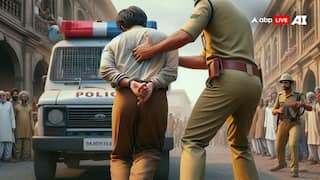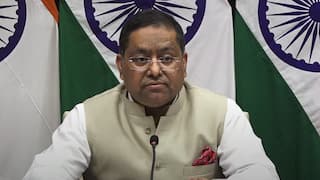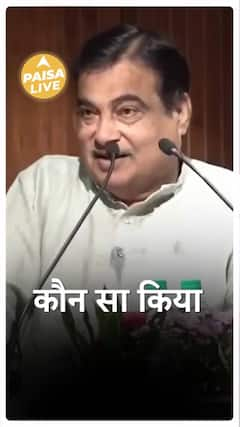Mrs. Chatterjee Vs Norway Review: Rani Mukerji Starrer Is A Technically Fine Film But Lacks Emotional Depth
'Mrs. Chatterjee Vs Norway' starring Rani Mukerji is inspired from real life events involving Sagarika Chakraborty, who had been living in Norway, whose children were forcibly removed from her

Ashima Chibber
Rani Mukerji Jim Sarbh Anirban Bhattacharya Neena Gupta
New Delhi: 'Mrs. Chatterjee Vs Norway' starring Rani Mukerji is inspired from events in real life involving Sagarika Chakraborty, a woman who had been living in Norway, whose children were forcibly removed from her by the Norwegian state in 2011. Rani Mukerji portrays the titular character in the film which does its music, screenplay, performance right and yet does not land the way it should have .
'Mrs. Chatterjee Vs Norway' opens with a quote from Rudyard Kipling: 'God could not be everywhere, and therefore he made mothers'. Soon after, the title card of the film is accompanied with a disclaimer that says 'inspired by true events' already creating a certain expectation of what is to follow. Why one mentions this, is because many filmmakers reveal that a film is inspired or adapted by real life incidents either at the beginning of a film or at the end of it. Both create their own kind of impression and with the disclaimer put in place in the beginning of the film, it creates a different sense of expectation, also a predisposition towards empathy for the titular character even before the film begins.
Having said that, to what extent can a filmmaker take liberties with her material? Can reality be misconstrued, misrepresentted or melodramatized to an extent that a real-life inspired film begins to feel like a mockery of it? 'Mrs. Chatterjee Vs Norway' has its problems at the heart of the subject matter but not how they are represented.
'Mrs. Chatterjee Vs Norway' begins with a dramatic chase opening sequence showing a harrowed Rani Mukerji in a yellow and red saree running behind an SUV which is taking her kids away from her. The sheer image of a brightly-clad Indian woman in a gray landscape of the Norwegian state sets the tone of Rani's character from the very first frame. As a character, Mrs. Chatterjee, despite her attempts to fit in, does not fit in the urban, highly-evolved society of Norway. She in her sarees with her loud Bengali persona is set to challenge every element of patriarchy and racism that comes reigning down on her family.
The opening sequence is followed by an extended song sequence which is organically linked to the plot and 10 minutes into the film; as an audience you are completely hooked and rooting for Mrs. Chatterjee.
The plot is quite dense, there is barely a moment of pause in the screenplay to sit and reflect on what is going on. There is one bomb after the other which is dropped in the form of child welfare services, corruption, racism, domestic violence, unhappy marriage etc etc. And, thankfully, as an audience we are left to uncover the what, why, how of the plot along with the lead character of the film. The literal and metaphorical spoon feeding the audience is thankfully absent in Mrs. Chatterjee Vs Norway'.
For a one-toned thematic film, which involves Rani Mukerji in the fight against the system, music is music is integrated to the form as is the use of background score to heighten the tension. At various moments in 'Mrs. Chatterjee Vs Norway' feels more like a thriller, with its background score, editing and the style of revealing important plot motives. The heightened melodramatic streak to appeal to a populist template of cinema is a shabby attempt to go 'entertainer'.
As for performances, Rani Mukerji is A-game in the film. However, despite all the modern day 'Mother India' drama, sometimes the emotion does not land in the most poignant moments of 'Mrs. Chatterjee Vs Norway'. In fact, it is in the blank spaces or in the songs, that the heartbreak, the suffering of Rani Mukherji's character comes across and not sometimes in her angry or emotional outbursts on 'mamta'.
Jim Sarbh has a crucial role in the film, though not so well-etched out( in a good way), also has a commendable performance to his credit. In fact, the tonality between Rani's performance and that of Jim Sarbh also create stark contrasts between a man totally entrenched and integrated in the Norwegian socio-cultural ethos Vs an Indian woman totally against it. They also repressent two vortexes of reality; one deeply deified( representing all the problematics of unchallengingly right morality)and the other deeply human and complex.
Neena Gupta also has a minimal appearance in the film, where she plays the role of late India Foreign Minister Sushma Swaraj.
Anirban Bhattacharya portrays the abusive and manipulative partner of Rani Mukerji. Anirban manages to ace the vile, cunning and abusive nature of his character without being obvious and loud; something found so often in such roles in films.
'Mrs. Chatterjee Vs Norway' is a two part film before and after the interval. There is a high and crash in the pre-interval film and another buildup and climax towards the end of the second half. And, despite following the three-act structure, 'Mrs. Chatterjee' has a potential of catharsis/torrential release of emotions throughout the film, thanks to the agony Rani's character is put in. For this reason, 'Mrs Chatterjee Vs Norway' goes way too overboard in trying to appeal to the audience with slam dunk melodrama.
The post-interval 'Mrs. Chatterjee Vs Norway' is well-edited and staged. Unnecessary time usage in explaining a case to Jim Sarbh( who plays a lawyer) or manually showing the time gap between day 1, day 2 and day 3 of a hearing not only save a lot of time on screen but also ensure the tautness of the screenplay is held( and as mentioned earlier, relates more to the thriller genre).
This controlled tension, drama does not overwhelm the audience or make the film overly dramatic once it shifts to the courtroom scenario where such films tend to become. And, there are a million examples of films in the popular masala entertainer space which do that.
There is also a different sensitivity with which patriarchy is shown every time a woman filmmaker is behind the lens. Typical everyday abusive behaviour like mother sleeping in the same bed as her son when the wife sleeps on the couch outside, or the arrogant entitled sense of owing the wife, hitting her at one's whim, declaring the woman 'mad' and incapable of taking care of her kids,etc etc. are never shown in a moral-preachy-or making a statement sort of manner. There is no staging them unrealistically or too realistically. All of this is commendably done in a matter-of-factly manner to show the realities women live and resign themselves to.
Interestingly, there is also a gradual toning of passion in Rani's character; from her high-pitched screaming, maddening passion to rescue her kids to her more resigned self towards the end of the film.
There is also a scaling of shots from master to mid to closeups towards the end of the film. As the audience gets more and more engaged in the narrative and begins to empathize and relate more to the lead character, the frames get tighter and as do the closeups.
The dialogue of 'Mrs. Chatterjee V/s Norway' deserves to be noted. There is nothing of the typical, dramatic, over the top lecturing on motherhood used in the film. There is a naturalized well-integrated dialogue in everyday language which is used in the film.
Despite all this, there is a certain lack of depth in ‘Mrs Chatterjee Vs Norway’ which all this technical astuteness cannot answer for. Despite the honest attempt by the actors and the filmmaker, the film does not have that kind of gravitas to land this well-rounded story that stays with you when you walk out of the theatre.
Top Headlines
Trending News






































